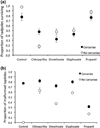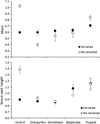Combined Effects of Pesticides and Trematode Infections on Hourglass Tree Frog Polypedates cruciger
- PMID: 26911919
- PMCID: PMC4852980
- DOI: 10.1007/s10393-016-1103-2
Combined Effects of Pesticides and Trematode Infections on Hourglass Tree Frog Polypedates cruciger
Abstract
The impact of widespread and common environmental factors, such as chemical contaminants, on infectious disease risk in amphibians is particularly important because both chemical contaminants and infectious disease have been implicated in worldwide amphibian declines. Here we report on the lone and combined effects of exposure to parasitic cercariae (larval stage) of the digenetic trematode, Acanthostomum burminis, and four commonly used pesticides (insecticides: chlorpyrifos, dimethoate; herbicides: glyphosate, propanil) at ecologically relevant concentrations on the survival, growth, and development of the common hourglass tree frog, Polypedates cruciger Blyth 1852. There was no evidence of any pesticide-induced mortality on cercariae because all the cercariae successfully penetrated each tadpole host regardless of pesticide treatment. In isolation, both cercarial and pesticide exposure significantly decreased frog survival, development, and growth, and increased developmental malformations, such as scoliosis, kyphosis, and also edema and skin ulcers. The combination of cercariae and pesticides generally posed greater risk to frogs than either factor alone by decreasing survival or growth or increasing time to metamorphosis or malformations. The exception was that lone exposure to chlorpyrifos had higher mortality without than with cercariae. Consistent with mathematical models that suggest that stress should increase the impact of generalist parasites, the weight of the evidence from the field and laboratory suggests that ecologically relevant concentrations of agrochemicals generally increase the threat that trematodes pose to amphibians, highlighting the importance of elucidating interactions between anthropogenic activities and infectious disease in taxa of conservation concern.
Keywords: Chlorpyrifos; Dimethoate; Glyphosate; Malformation; Propanil.
Figures





References
-
- Aponso GLM, Magamage C, Ekanayake WM, Manuweera GK. Analysis of water for pesticides in two major agricultural areas of the dry zone. Annals of the Sri Lanka Department of Agriculture. 2003;5:7–22.
-
- Berven KA. Factors affecting population fluctuations in larval and adult stages of the Wood Frog (Rana sylvatica) Ecology. 1990;71:1599–1608.
-
- Blanar CA, Munkittrick KR, Houlahan J, MacLatchy DL, Marcogliese DJ. Pollution and parasitism in aquatic animals: A meta-analysis of effect size. Aquatic Toxicology. 2009;93:18–28. - PubMed
-
- Blaustein AR, Kiesecker JM. Complexity in conservation: lessons from the global decline of amphibian populations. Ecology Letters. 2002;5:597–608.
-
- Bridges C, Little E, Gardiner D, Petty J, Huckins J. Assessing the toxicity and teratogenicity of pond water in north-central Minnesota to amphibians. Environmental Science and Pollution Research. 2004;11:233–239. - PubMed
Publication types
MeSH terms
Substances
Grants and funding
LinkOut - more resources
Full Text Sources
Other Literature Sources

